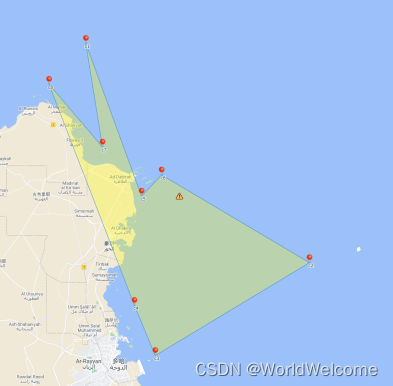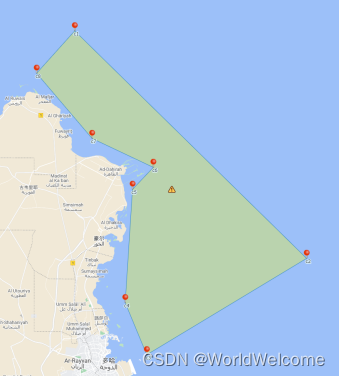目的
- 一个点集合,可以输出多个不交叉的多边形;本文中的Class,只能做到输出其中的一个,即:按夹角大小排序。(如下图左)
- 不按夹角大小排序,也能输出得到不交叉的多边形(如下图右)。所以: 实际应用中,往往还是要根据实际情况来给各点排序、输出符合需求的多边形(如下图右);纯粹依赖排序这样的纯技术思维是不可取的。
输出图例


代码
1.PolygonSort
package util.polygon_sort;
import java.util.Comparator;
import java.util.HashMap;
import java.util.Map;
import java.util.TreeMap;
/*
* 点集合构造简单多边形,按逆时针,排序夹角,达到:边与边无交叉。
* 一个点集合,可以输出多个不交叉的多边形;此类只能做到输出其中的一个。
* 实际应用中,往往还是要根据实际情况来排序各点输出想要的多边形,而不是绝对按照夹角大小来排序。
* Author:James Wang
*/
public class PolygonSort{
public static void main(String[] args) {
/*
Coordinate p1 = new Coordinate(53.0418333,24.9208333);//经度在前,纬度在后。
Coordinate p2 = new Coordinate(53.0446667,24.9175);
Coordinate p3 = new Coordinate(53.0448333,24.9045);
Coordinate p4 = new Coordinate(53.0481667,24.9211667);
Coordinate p5 = new Coordinate(53.057,24.8946667);
Coordinate p6 = new Coordinate(53.0568333,24.8938333);
Coordinate p7 = new Coordinate(54.0568333,24.9038333);
Coordinate[] pList = { p1,p2,p3,p4,p5,p6,p7 };
Map<Double,Coordinate> sortedMap = sort(pList) ;
for (Map.Entry<Double,Coordinate> entry:sortedMap.entrySet() ){
System.out.println("angle=" + entry.getKey() +",坐标等于 " + entry.getValue().toString() );
}
*/
//String s = "POLYGON((63.2505 24.6003333,62.5005 24.6003333,62.5005 24.3503333,63.2505 24.3503333))";
String s = "POLYGON((51.41 26.352,52.2375 25.6245,51.6675 25.3138333,51.5903333 25.4816667,51.617 25.8458333,51.6913333 25.9155,51.4716667 26.0091667,51.275 26.2171667))";
s = s.substring("POLYGON((".length(),s.lastIndexOf("))"));
String[] ar = s.split(",");
Map<Double,Coordinate> sortedMap2 = sort(ar) ;
for (Map.Entry<Double,Coordinate> entry:sortedMap2.entrySet() ){
System.out.println("angle=" + entry.getKey() +",坐标等于 " + entry.getValue().toString() );
}
}
/* https://www.cnblogs.com/andyzeng/p/3754005.html
* 点集合构造 简单多边形,排序 夹角,达到:边与边无交叉。
*/
public static Map<Double,Coordinate> sort(Coordinate[] pList) {
int minIdx = findMinLat(pList);
Map<Double,Coordinate> bMap = getAngleMap(pList,minIdx);
Map<Double,Coordinate> sortedMap = new TreeMap<Double,Coordinate>(new MapKeyComparator());
sortedMap.putAll(bMap);
/*double[] angle = getAngleList(pList,minIdx);
/double[] sortedAngle = ArraySort.bubbleSort(angle,"asc");*/
return sortedMap;
}
/*
* 计算每个点到最小纬度点的angle
*/
public static Map<Double,Coordinate> getAngleMap(Coordinate[] pList,int minIdx) {
Map<Double,Coordinate> map = new HashMap<Double,Coordinate>();
double angle = 0;
for(int i=0;i<pList.length;i++) {
angle = 0;
if( i != minIdx ) {
angle = aTan2(pList[minIdx],pList[i]);
System.out.println( (i+1) + "->" + (minIdx+1) + ":角度"+ angle);
}
map.put(angle,pList[i]);
}
return map;
}
/*
public static double[] getAngleList(Coordinate[] pList,int minIdx) {
double[] angleList = new double[pList.length];
for(int i=0;i<pList.length;i++) {
if( i != minIdx ) {
angleList[i] = aTan2(pList[minIdx],pList[i]);
System.out.println( (i+1) + "->" + (minIdx+1) + ":角度"+ angleList[i]);
}else {
angleList[i] = 0;
}
}
return angleList;
}
*/
/*
* 找到最小lat的起点point,
* 起点,在所有的其它点的下面,这样 其它点到起点的角度angle,都为正值(0度~180度),容易排序
*/
public static int findMinLat(Coordinate[] pList) {
int minIdx = 0;
double min = 10000000;
int minIdx2 = -1 ;
for(int i=0;i<pList.length;i++) {
if( pList[i].getLat() < min ) {
min = pList[i].getLat();
minIdx = i;
}else if(pList[i].getLat() == min ) {
minIdx2 = i;
}
}
//System.out.println( "------第一遍---------最小lat的point的序号 为: " + (minIdx+1) + "=数组游标" + minIdx + "+1");
if( minIdx2 >=0 ) {
//System.out.println( "------第2遍---------最小lat的point的序号 为: " + (minIdx+1) + "=数组游标" + minIdx + "+1");
if( pList[minIdx2].getLon() > pList[minIdx].getLon() ) {
return minIdx2;
}else if(pList[minIdx2].getLon() > pList[minIdx].getLon() ){
System.out.println( "存在完全相同的点,不正常,手工剔除它们");
return -1;
}
}
return minIdx;
}
public static double aTan2(Coordinate p1,Coordinate p2) {//注意这里的aTan2返回degree,not radian
double x = p2.getLon() - p1.getLon();
double y = p2.getLat() - p1.getLat();
//System.out.print(y + "," + x );
return Math.toDegrees( Math.atan2(y,x) );
}
/*java的atan2函数学习例子 */
public static void test() {
double d = 45;
double dR = Math.toRadians(d);//角度 转 弧度
//System.out.println( (d* 180) / Math.PI);
System.out.println( "tag " + d+ "(角)度=弧度:" + dR + "=" + Math.tan(dR) + ",约等于1, Math.atan(dR)= " + Math.atan(dR));//0.9999999999999999 约 等于 1
//System.out.println( "atag45度=" + Math.atan(dR) + ",这个非常奇怪不等于 Math.tan !!");//0.9999999999999999
System.out.println( "java.lang.Math.atan2()是已知一个角的正切值(也就是 y/x),求该角的弧度值。比如:Math.atan2(1,1) = "
+ Math.atan2(1,1) + ",转换成角度=" + Math.toDegrees( Math.atan2(1,1) ));//0.9999999999999999
double dR30 = Math.toRadians(30);
System.out.println("---------");
System.out.println("正玄sin 30度=1/2=" + Math.sin(dR30) + "");//
System.out.println("反正玄 asin 30度=2/1=" + Math.asin(dR30) + ",1/Math.sin(dR30)=" + (1/Math.sin(dR30) ) );//
System.out.println("---------");
System.out.println("cos 30 度=sqrt(3)/2=" + Math.cos(dR30) + ", 而手工计算(Math.sqrt(3)/2)= " + (Math.sqrt(3)/2)
);//
System.out.println("tag 30 度=1/sqrt(3)=" +Math.tan(dR30) + ", 而手工计算(1/Math.sqrt(3))= " + (1/Math.sqrt(3)));//
System.out.println(Math.atan(dR30) + ",squar(3)/1=" + Math.sqrt(3));//
System.out.println("---------");
Coordinate p1 = new Coordinate(0,0);
Coordinate p2 = new Coordinate(1,1);
Coordinate p3 = new Coordinate(-1,Math.sqrt(3));
System.out.println( aTan2(p1,p2) + ",角度=" + Math.toDegrees(aTan2(p1,p2) ));
System.out.println( aTan2(p1,p3) + ",角度=" + Math.toDegrees(aTan2(p1,p3) ));
}
public static Map<Double,Coordinate> sort(String[] strList) {
Coordinate[] pList = new Coordinate[strList.length];
Coordinate p = null;
double lat,lon;
for( int i=0;i<strList.length;i++) {
lon = Double.parseDouble(strList[i].split(" ")[0]);//经度在前,维度在后。
lat = Double.parseDouble(strList[i].split(" ")[1]);
p = new Coordinate(lat,lon);
pList[i] = p;
System.out.println( (i+1) + " 点:lat=" + lat + " lon= " + lon );
}
return sort(pList);
}
}
class MapKeyComparator implements Comparator<Double>{
@Override
public int compare(Double angle1, Double angle2) {
if( angle1>angle2 ) {
return 1;
}else if(angle1 < angle2 ){
return -1;
}else{
return 0;
}
}
}2.Coordinate
package util.polygon_sort;
public class Coordinate {
double lat;
double lon;
public Coordinate(double lon,double lat) {//经度在前,纬度在后。
this.lat = lat;
this.lon = lon;
}
public Coordinate(String lon,String lat) {//经度在前,纬度在后。
this.lat = Double.parseDouble(lat);
this.lon = Double.parseDouble(lon);
}
public void setLat(double lat) {
this.lat = lat;
}
public double getLat() {
return lat;
}
public void setLon(double lon) {
this.lon = lon;
}
public double getLon() {
return lon;
}
@Override
public String toString() {
return lon + " " + lat ;
}
}























 747
747











 被折叠的 条评论
为什么被折叠?
被折叠的 条评论
为什么被折叠?








